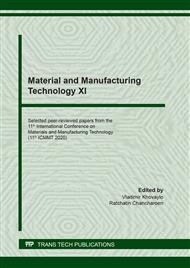p.114
p.123
p.131
p.141
p.147
p.153
p.160
p.166
p.172
Performance of 500 Liter Stainless Steel Portable Biogas Anaerobic Digester with Agitator Designed for the Tropical Developing Country
Abstract:
This document it is established that 2 types of biogas anaerobic digester that usually found in developing country. First type is fixed dome type of anaerobic digester and secondly is floating drum biogas anaerobic digester. Both of this type have draw back that the anaerobic process is not completed with agitation process that yield low rate of biogas production. Other serious problem is the release of slurry cannot optimal. Some of the slurry will still remain stay in the anaerobic digester especially scum. To drain and cleaning the fixed dome or floating drum biogas anaerobic digester is mandatory to be done regularly that consume time and cost. The fixed dome types as well as floating drum type are usually not portable which cause no possibility to relocate in the new site. It is the purpose of this work to introduce portable biogas anaerobic digester that suitable for developing country with volume of digester around 500 liter of slurry. The requirement of agitator is facilitated, and the anaerobic digester is possible to be operated in batch system or continuous system. The material that is used for anaerobic digester is stainless steel 304 with tungsten inert gas welding technology that is used for the manufacturing. With this design the anaerobic digester are easy to be maintenance. The batch system can keep producing biogas until 52 day with total production of biogas around 3320 liters. The continuous system was conducted by releasing for about 5 liters slurry from the outlet and after that filled with new slurry with stirring with agitator was conducted for about 10 minutes for 3 times in a day (morning, noon, and evening). The result for continuous system is a linear biogas production with rate biogas production is around 51.7 liter/day (1550 liter/30days).
Info:
Periodical:
Pages:
160-165
Citation:
Online since:
February 2021
Keywords:
Price:
Сopyright:
© 2021 Trans Tech Publications Ltd. All Rights Reserved
Share:
Citation:


